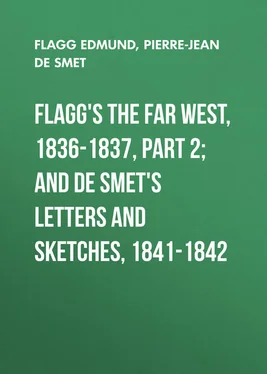Edmund Flagg - Flagg's The Far West, 1836-1837, part 2; and De Smet's Letters and Sketches, 1841-1842
Здесь есть возможность читать онлайн «Edmund Flagg - Flagg's The Far West, 1836-1837, part 2; and De Smet's Letters and Sketches, 1841-1842» — ознакомительный отрывок электронной книги совершенно бесплатно, а после прочтения отрывка купить полную версию. В некоторых случаях можно слушать аудио, скачать через торрент в формате fb2 и присутствует краткое содержание. Издательство: Иностранный паблик, Жанр: foreign_antique, foreign_prose, на английском языке. Описание произведения, (предисловие) а так же отзывы посетителей доступны на портале библиотеки ЛибКат.
- Название:Flagg's The Far West, 1836-1837, part 2; and De Smet's Letters and Sketches, 1841-1842
- Автор:
- Издательство:Иностранный паблик
- Жанр:
- Год:неизвестен
- ISBN:нет данных
- Рейтинг книги:4 / 5. Голосов: 1
-
Избранное:Добавить в избранное
- Отзывы:
-
Ваша оценка:
- 80
- 1
- 2
- 3
- 4
- 5
Flagg's The Far West, 1836-1837, part 2; and De Smet's Letters and Sketches, 1841-1842: краткое содержание, описание и аннотация
Предлагаем к чтению аннотацию, описание, краткое содержание или предисловие (зависит от того, что написал сам автор книги «Flagg's The Far West, 1836-1837, part 2; and De Smet's Letters and Sketches, 1841-1842»). Если вы не нашли необходимую информацию о книге — напишите в комментариях, мы постараемся отыскать её.
Flagg's The Far West, 1836-1837, part 2; and De Smet's Letters and Sketches, 1841-1842 — читать онлайн ознакомительный отрывок
Ниже представлен текст книги, разбитый по страницам. Система сохранения места последней прочитанной страницы, позволяет с удобством читать онлайн бесплатно книгу «Flagg's The Far West, 1836-1837, part 2; and De Smet's Letters and Sketches, 1841-1842», без необходимости каждый раз заново искать на чём Вы остановились. Поставьте закладку, и сможете в любой момент перейти на страницу, на которой закончили чтение.
Интервал:
Закладка:
60
A fort was begun by Charles Trent, with a few Virginia troops, in February, 1754. On April 17, Contrecœur took the place, completed the fort, and named it Duquesne in honor of the then governor of New France. See Croghan's Journals , in our volume i, p. 85, note 45; also F. A. Michaux's Travels , in our volume iii, p. 156, note 20. – Ed.
61
Renault sailed from France in 1719, but did not reach Illinois until 1721. For a short sketch of Renault, see ante , p. 42, note 18.
St. Philippe, five miles from Fort Chartres on the road to Cahokia, was founded about 1725 by Renault, on a tract granted to him in 1723. Philip Pittman, who visited the place in 1766, wrote that there were about sixteen houses and a small church left standing, although all the inhabitants save the captain of the militia had crossed the Mississippi the preceding year. In 1803, John Everett was the sole inhabitant. – Ed.
62
For location and settlement of Herculaneum, see Maximilian's Travels , in our volume xxii, p. 212, note 122; for the shot-towers there, see our volume xxvi, p. 103, note 66. – Ed.
63
Milk-sickness, no longer so diagnosed by medical authorities, is described by early writers in the Middle West as a malignant disease attacking both men and stock. It was supposed that the disease was contracted by eating the flesh or dairy products of animals that had grazed on a certain weed. In the case of the human being the symptoms were intolerable thirst, absolute constipation, low temperature, an extreme nervous agitation, but with an absence of chills and headaches. Recovery seemed to be the exception. Although no specific remedy was used, the best results were thought to be obtained by judicious stimulation and careful nursing. The same disease among stock was usually known as "trembles." The symptoms were the same as with men, and death followed, generally within eight or ten days. A farm where this dreaded disease had come was called a "milk-sick farm," and was rendered almost unsalable. For a later and more detailed account, see Thomas L. M'Kenney, Memoirs, official and personal, with Sketches of Travels among the Northern and Southern Indians , etc. (New York, 1846), p. 141. Dr. William M. Beach, a pioneer physician in Ohio, who had had much experience with milk sickness, wrote an article for Albert H. Buck, Reference Handbook of Medical Science (New York, 1884-87), volume v. An abstract of the above article by Beach is given in the edition for 1902. – Ed.
64
Two ranges of cliffs are known by this name. One is below Ste. Genevieve. – Flagg.
65
For further information on the pigmy cemetery in the Meramec, see our volume xxvi, p. 105. – Ed.
66
Mr. Flint's remarks respecting the Ancient Pottery found in the West coincides so well with the result of my own more limited observation, that I subjoin them in preference to extended description myself. Preceding these remarks is an interesting notice of the Lilliputian graves on the Merrimac, to which allusion has several times been made.
"At the time the Lilliputian graves were found on the Merrimac, in the county of St. Louis, many people went from that town to satisfy their curiosity by inspecting them. It appears from Mr. Peck that the graves were numerous; that the coffins were of stone; that the bones in some instances were nearly entire; that the length of the bodies was determined by that of the coffins which they filled, and that the bodies in general could not have been more than from three feet and a half to four feet in length. Thus it should seem that the generations of the past in this region were mammoths and pigmies.
"I have examined the pottery, of which I have spoken above, with some attention. It is unbaked, and the glazing very incomplete, since oil will soak through it. It is evident, from slight departure from regularity in the surface, that it was moulded by the hand and not by anything like our lathe. The composition, when fractured, shows many white floccules in the clay that resemble fine snow, and this I judge to be pulverized shells. The basis of the composition appears to be the alluvial clay carried along in the waters of the Mississippi, and called by the French 'terre grasse,' from its greasy feel. Samples of this pottery, more or less perfect, are shown everywhere on the river. Some of the most perfect have been dug from what are called the 'chalk-banks,' below the mouth of the Ohio. The most perfect that I have seen, being, in fact, as entire as when first formed, was a vessel in my possession. It was a drinking jug, like the 'scyphus' of the ancients. It was dug from the chalk-bank. It was smooth, well-moulded, and of the colour of common gray stoneware. It had been rounded with great care, and yet, from slight indentations on the surface, it was manifest that it had been so wrought in the palm of the hand. The model of the form was a simple and obvious one – the bottle-gourd – and it would contain about two quarts. This vessel had been used to hold animal oil; for it had soaked through, and varnished the external surface. Its neck was that of a squaw, known by the clubbing of the hair, after the Indian fashion. The moulder was not an accurate copyist, and had learned neither statuary nor anatomy; for, although the finish was fine, the head was monstrous. There seemed to have been an intention of wit in the outlet. It was the horrible and distorted mouth of a savage, and in drinking you would be obliged to place your lips in contact with those of madam the squaw." — Flint's Recollections , p. 173-4. – Flagg.
Comment by Ed. For bibliography on Indian antiquities, see our volume xxvi, p. 69, note 33; p. 159, note 111; and p. 184, note 128.
67
Waterloo, in Monroe County, about thirty miles northwest of Kaskaskia, was incorporated in 1848. In 1818 George Forquer purchased the land on which the village now stands, and in the same year he and Daniel P. Cook (later a member of Congress) laid out and named the town. In 1825 the county seat was changed from Harrisonville to Waterloo. About 1830, John Coleman erected a large wind-mill, later changed to an ox-mill (1837).
Bellefontaine is the name applied by the early French to a large spring a mile south of the present site of Waterloo. In 1782 Captain James Moore, who had served under George Rogers Clark, settled at this spring, and in accordance with orders from the Virginia government built a blockhouse fort as a protection against the Indians. Owing to his tact and good judgment, amicable relations with the Indians were maintained until 1786, when serious trouble really began. During the next decade the Indians killed several whites. – Ed.
68
Columbia, eight miles north of Waterloo, and fifteen miles south of St. Louis, was laid out in 1820 on land belonging to Louis Nolan. – Ed.
69
With reference to the American Bottom, see Ogden's Letters from the West , in our volume xix, p. 62, note 48. – Ed.
70
See our volume xxvi, p. 263, note 163. – Ed.
71
The passage subjoined relative to the Geological Transformations which have taken place in the Mississippi Valley, is extracted from "Schoolcraft's Travels in its central portions," and will be found abundantly to corroborate my own observations upon the subject.
"It seems manifest, from various appearances, that the country we have under consideration has been subjected to the influence of water at a comparatively recent period; and it is evident that its peculiar alluvial aspect is the distinct and natural result of the time and the mode in which these waters were exhausted. One striking fact, which appears to have escaped general observation, is, that at some former period there has been an obstruction in the channel of the Mississippi at or near Grand Tower, producing a stagnation of the current at an elevation of about one hundred and thirty feet above the present ordinary water-mark. This appears evident from the general elevation and direction of the hills, which, for several hundred miles above, are separated by a valley from twenty to twenty-five miles wide, which now deeply imbosoms the current of the Mississippi. Wherever these hills disclose rocky and precipitous fronts, a series of distinctly-marked antique water-lines are to be observed. These water-lines preserve a parallelism which is very remarkable, and, what we should expect to find, constantly present their greatest depression towards the sources of the river. At Grand Tower they are elevated about one hundred and thirty feet above the summit level, at which elevation we observe petrifactions of madrepores and various other fossil organic remains which belong to this peculiar era. Here the rocks of dark-coloured limestone, which pervade the country to so great an extent, project towards each other as if they had once united; but, by some convulsion of nature, or, what is still more probable, by the continued action of the water upon a secondary rock, the Mississippi has effected a passage through this barrier, and thus producing an exhaustion of the stagnant waters from the level prairie lands above." — Schoolcraft's Travels , p. 218, 219. – Flagg.
Читать дальшеИнтервал:
Закладка:
Похожие книги на «Flagg's The Far West, 1836-1837, part 2; and De Smet's Letters and Sketches, 1841-1842»
Представляем Вашему вниманию похожие книги на «Flagg's The Far West, 1836-1837, part 2; and De Smet's Letters and Sketches, 1841-1842» списком для выбора. Мы отобрали схожую по названию и смыслу литературу в надежде предоставить читателям больше вариантов отыскать новые, интересные, ещё непрочитанные произведения.
Обсуждение, отзывы о книге «Flagg's The Far West, 1836-1837, part 2; and De Smet's Letters and Sketches, 1841-1842» и просто собственные мнения читателей. Оставьте ваши комментарии, напишите, что Вы думаете о произведении, его смысле или главных героях. Укажите что конкретно понравилось, а что нет, и почему Вы так считаете.












